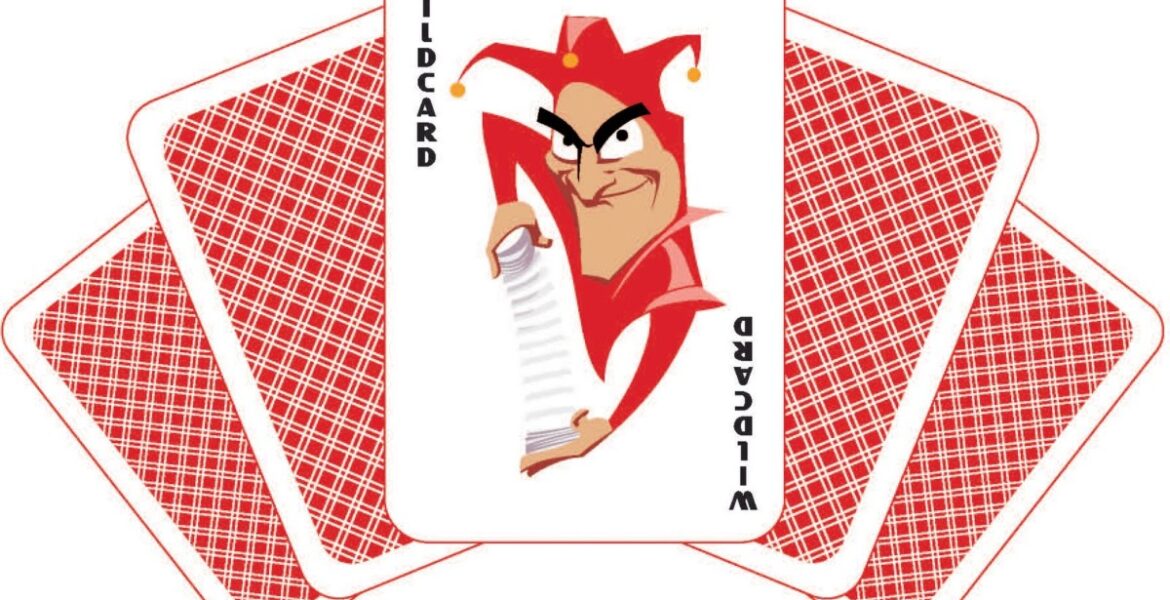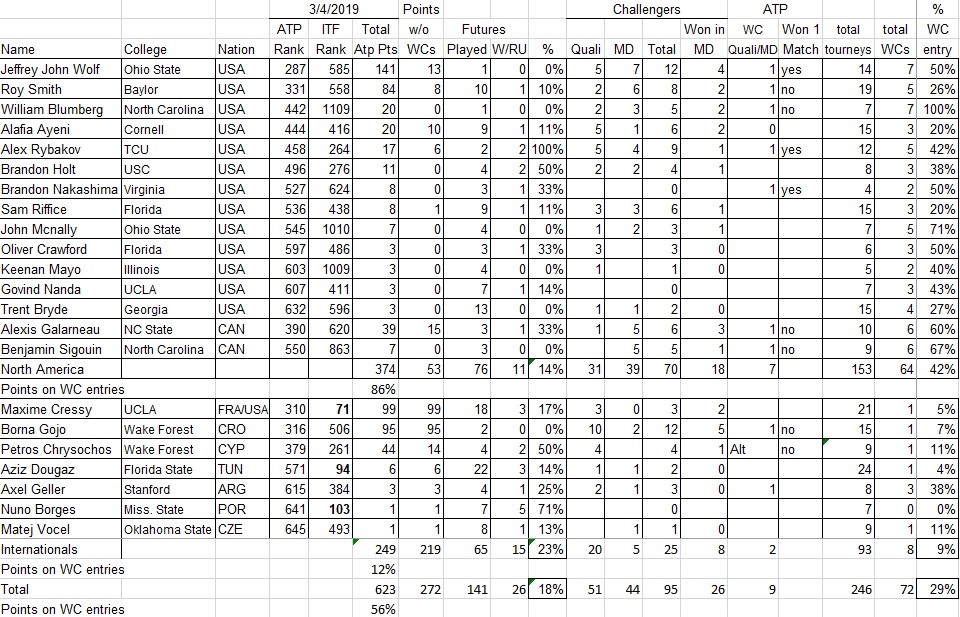Do North American Collegians Rely too Much on Wild Cards?

Up Next
Young Players & Social MediaToday’s Guest Post was written by a member of the ParentingAces Community who also happens to be an accountant. This analysis goes hand-in-hand with the previous article regarding why two professional tours are problematic for players. If you have any questions or need clarification, please post in the Comments below.
Currently there are 23 players who are/were enrolled in college for 2018/19 who have earned ATP points in the final rounds of $25ks or in Challengers-15 from North America and 8 from other continents. 56% of ATP points were earned in tournaments in which the players received wild cards. However, there is a stark difference between points earned on wild cards between North Americans and players from the rest of the world. 86% of ATP points earned by North American players were won in tourneys they entered via Wild Cards (see chart below). 42% of all the tourneys those North Americans played were entered via WCs. If Futures were excluded, the percentage of entry on WCs would be much higher. For most North Americans, if they got into a Challenger main draw, it was via WC.
International collegians excluding the two Canadians earned 12% of their ATP points from WCs and gained entry into 9% of tournaments played via wild cards. The international players played more Futures-averaging close to 10 per player over the last year with Maxime Cressy (UCLA) playing 18 and Aziz Dougaz (Florida State) playing 22. Only two Americans played 10 or more Futures-Roy Smith (Baylor) who took off the fall and Trent Bryde (UGA) who did not start at University of Georgia until January.
In Amir’s recent article about the two ranking systems, he stated for a player to be able to enter Challengers on ITF points, the player would need to be ranked around ITF 20. However only three collegians have ITF world rankings in the 70-low 100s range. No current collegian has close to the ITF ranking needed to get in Challengers on that basis. The highest ranked collegians without ATP points but with ITF world ranking are ranked around 400 ITF world. Amir predicted players would need to win five $25ks to reach a top 20 ITF ranking. However even current collegians with ATP points have performed poorly or inconsistently at Futures. Out of 65 Futures entered at either the Quali or main draw level, North American collegians with ATP points only reached finals at 14% of those events. International collegians performed slightly better reaching the finals of 23% of Futures entered.
What these numbers and the ending notes show is that players gradually improve on the pro circuit and have occasional dramatically good results. For example, Roy Smith (Baylor) lost in the Qualie rounds of four Futures in the summer of 2018 but reached a final of a Challenger that fall. However, he only won main draw Challenger points at one other Challenger out of the 7 others he played. Unlike pro players who have been playing year-round for multiple years, collegians are unlikely to win 5 Futures in a year, let alone in six months.
Looking at the notes below the chart, while 2 players have won a Challenger-Cressy (UCLA) and Wolf (Ohio State), no player has won more than one $25K in a year; ten have won a single $25K and several have also won $15Ks. If the criteria to enter Challengers is based on winning multiple $25K Futures, the collegians will be out of luck without wild cards. Only four collegians reached the finals (or won) of 50% or more of the Futures they played-Rybakov (TCU) was 2 for 2 at US Futures, Nuno Borges (Mississippi State) mainly played $15Ks in Portugal and reached 5 finals, and Petros Chrysochos (Wake Forest) and Brandon Holt (USC) reached finals at the two USA Futures.
In 2018, collegians could use ATP points won in all rounds of $15K and $25K Futures to enter 16 or 32 draw Challenger qualifiers. Now with only 4 draw Challenger Qualies with only 1 entry from wild card and the rest from ITF ranking, collegians who are not already ranked in top 300 won’t be able to play Challenger main draw or Qualies without wild cards. Players used wild cards last year, but there will be fewer this year. In 2018, challengers had 16-32 draw qualifiers with up to 6 wild cards and then 4 wild cards into main draw for up to 10 wild cards per Challenger.
In 2019, there are five wild cards in main draw and one in the qualifier for a 40% reduction in wild cards. North American players who relied on wild cards to earn their ATP points last year may not received as many wild cards in 2019. The fact that many players won Challenger main matches after receiving wild cards shows this route is a successful one for collegians even if they did not win main draw matches at every Challenger. Out of 70 Challengers played by these North Americans (including those entered in the Quali draw), main draw matches were won in only 18 tournaments-around 25%.
Implications that can be drawn from this analysis:
- If the top North American collegians are only reaching the finals of 14% of the Futures they play, either the North American Futures are incredibly tough with all the collegiate competitors, players need years not 6 months to develop the consistency to win multiple Futures, or some combination of both. A guy who lost in 4 Future Qualies reached the finals of a challenger less than 6 months later. The chances in 2019 of a player who loses in Qualies to have a chance to redeem himself later is slim. These changes don’t give players time to develop into the pros they can be.
- Because USTA owned Challenger WCs will only go to Americans, internationals may choose to attend only those US universities that host their own Challengers.
- More internationals may switch to US nationality to be able to earn wild cards. Maxime Cressy (UCLA) who had played tourneys as a Frenchmen switched nationality to US as he has an American mother. Other players who are longtime US residents could possibly switch nationalities. Cressy is counted as an international in this analysis as he played these tournaments as a Frenchmen.
- Universities in states without Challengers may lose out on international players. Consider Nuno Borges (Mississippi State) who reached the finals of 5 Futures but did not get to play a Challenger over the last year. Who will choose Mississippi State and similar top ranked schools when Ohio State, Virginia, and other elite tennis universities host Challengers on site?
- More top of the lineup players will miss dual matches if they are selected for wild cards into Challengers. Coaches and players will have to negotiate terms during recruiting. No longer will college players just play pro tourneys in the fall.
- There are many ITA ranked players with talent and UTRs similar to the 23 on this list without ATP points simply because they had access to no or fewer Challenger wild cards. Will they miss out on their chance to play pro?
- While there are 23 on this list today, there will be fewer in March of 2020 because of the reduction in Challenger qualifier draws.
- International players from countries without Challenger tournaments will be drawn to universities that host Challengers. These are players who would have tried the Tour but are shut out. There will be a lot of competition for slots at a handful of universities.
- Other international players who wish to play pro after college will decide to forego college when they realize they have a slim chance of earning wild cards in the US. North American players on the chart averaged 4+ wild cards in a year. Only one international player earned more than one wild card.
Notes: (bolded won a $25K Future or a Challenger
| Jeffrey John Wolf | Won Columbus CH,WCs into MD of 6 CH-won pts in 4, WC to Q Cincy 1000 |
| Maxime Cressy | Won 1 $25K, RU in 1 $15k, 1 $25K, only 1WC into Newport CH-Q |
| Borna Gojo | 1 WC into MD Winston Salem 250 |
| Roy Smith | Lost in 4 Future Qs, RU in Future w/WC, WC to CH-no pts, RU in CH w/WC, WC to NY Open Q |
| Petros Chrysochos | 1 WC- Irving CH Q-reached QF, alt in Winston 250 lost, won 1 $25K, RU 1 $25K |
| Alexis Galarneau | Earned in Canada 5 CH WC, one WC to 1000s |
| William Blumberg | WCs to all events, won pts in 2 CH, WC to Newport 250 Q |
| Alafia Ayeni | Won Canadian $25K out of Qs,2 WC to CH-Q, 1 WC to CH-MD |
| Alex Rybakov | 4 WCs MD-CH, 1 WC Newport 250 Quali, won 2 Futures (1 $25K) |
| Brandon Holt | WC into $25K Future won, WC into 2 CH-MD, also won $15K |
| Brandon Nakashima | WC into US Open Q-won 1 rd, won Future on WC (beat Cressy) |
| Sam Riffice | 3 WCs into MD-CH-won pts in 1 |
| John McNally | 3 Future WCs, 2 CH MD-WCs |
| Benjamin Sigouin | 5 Canadian CH-MD WCs, 1 WC Canadian 1000 |
| Aziz Dougaz | Won 1 $25K, 1 $15K, RU $15K, WC to CH-MD, mainly played inTunisia, USA |
| Oliver Crawford | Won 1 $25K, got in MD on WC. 2 WC CH-Q |
| Keenan Mayo | 1 WC into Future Q, 1 WC in CH-Q, qualified (3 pts ’18) |
| Govind Nanda | 3 WCs to MD Future, won $25K on WC |
| Axel Geller | WC to Miami 1000Q, $25K, MD-CH, won $25K w/o WC |
| Trent Bryde | 1 WC CH-Q, 1 WC-CH MD, no MD wins in 7/13 Futures, 2 WC Future Q |
| Nuno Borges | Won 2 $15K, RU in 2 $15k, one $25K, mainly played $15Ks in Portugal |
| Matej Vocel | 1 WC to MD Challenger |














Comments are currently disabled for this post